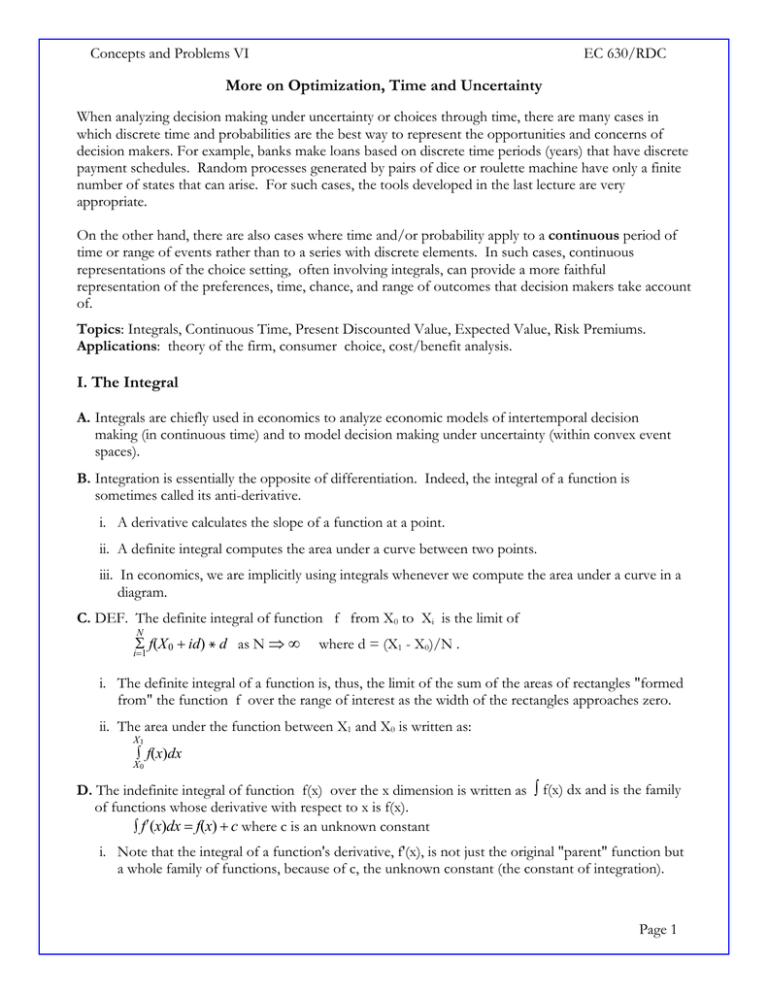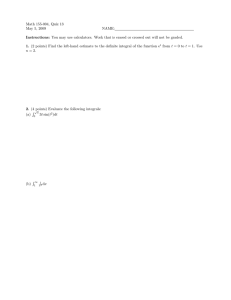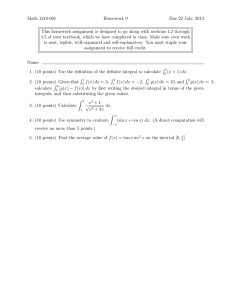More on Optimization, Time and Uncertainty
advertisement

Concepts and Problems VI EC 630/RDC More on Optimization, Time and Uncertainty When analyzing decision making under uncertainty or choices through time, there are many cases in which discrete time and probabilities are the best way to represent the opportunities and concerns of decision makers. For example, banks make loans based on discrete time periods (years) that have discrete payment schedules. Random processes generated by pairs of dice or roulette machine have only a finite number of states that can arise. For such cases, the tools developed in the last lecture are very appropriate. On the other hand, there are also cases where time and/or probability apply to a continuous period of time or range of events rather than to a series with discrete elements. In such cases, continuous representations of the choice setting, often involving integrals, can provide a more faithful representation of the preferences, time, chance, and range of outcomes that decision makers take account of. Topics: Integrals, Continuous Time, Present Discounted Value, Expected Value, Risk Premiums. Applications: theory of the firm, consumer choice, cost/benefit analysis. I. The Integral A. Integrals are chiefly used in economics to analyze economic models of intertemporal decision making (in continuous time) and to model decision making under uncertainty (within convex event spaces). B. Integration is essentially the opposite of differentiation. Indeed, the integral of a function is sometimes called its anti-derivative. i. A derivative calculates the slope of a function at a point. ii. A definite integral computes the area under a curve between two points. iii. In economics, we are implicitly using integrals whenever we compute the area under a curve in a diagram. C. DEF. The definite integral of function f from X0 to Xi is the limit of N fX 0 id d as N i1 where d = (X1 - X0)/N . i. The definite integral of a function is, thus, the limit of the sum of the areas of rectangles "formed from" the function f over the range of interest as the width of the rectangles approaches zero. ii. The area under the function between X1 and X0 is written as: X1 fxdx X0 D. The indefinite integral of function f(x) over the x dimension is written as f(x) dx and is the family of functions whose derivative with respect to x is f(x). f xdx fx c where c is an unknown constant i. Note that the integral of a function's derivative, f'(x), is not just the original "parent" function but a whole family of functions, because of c, the unknown constant (the constant of integration). Page 1 Concepts and Problems VI EC 630/RDC ii. For example, if the original function is a firm's marginal cost curve, the indefinite integral of that function is total variable cost plus an unknown constant which can be interpreted as fixed costs. iii. Given a specific value for f(x) one can usually compute “c” and so arrive at a unique solution for the integral. E. One can use an indefinite integral to find the definite integral of a function within a given range: X1 f xdx fX 1 fX 0 X0 i. The definite integral measures the change in the "parent" function, f(X), in moving from X0 to X1. ii. For example, the definite integral of a marginal cost function, c'(X), is the total variable cost of increasing output from X0 to X1. iii. Note that for a definite integral, the unknown constant term disappears as a consequence of the substraction, c - c = 0. For a definite integral, the “c” cancels out, so we can calculate a definite integral without knowing “c.” F. Some useful integration rules: i. a dx = ax + c (a is a constant, not a function of x) ii. axn dx = [ axn+1/n+1 ] + c (except n = -1, see iv below) iii. af'(x) dx = a f'(x) dx = af(x) + c iv. 1/x) dx = ln(x) + c v. erx dx = erx /r +c (e is the base of the natural log, 2.71828) vi. f(y) dy/dx dx = f(y) dy (substitution rule) vii. v du/dx dx = uv - u dv/dx (integration by parts) G. A routine microeconomic application. Suppose that you know marginal cost is equal to where Q is the level of output. 100 - .1Q i. Total cost is 100 - .1Q dQ = 100Q - .05Q2 + c where c is the unknown constant of integration. ii. Notice that total cost at 0 is just equal to c in this case. Consequently, “c,” the unknown constant of integration can be regarded as the firm's total fixed cost. iii. To determine the value of c in the example, it is sufficient to know the total cost of any particular output level. Substituting that cost (C) and output (Q) combination into C = 100Q - .05Q2 + c would allow us to solve for c. II. Intertemporal Choice, Time Discounting and Present Values A. In our last lecture, we developed the equation that represents the present discounted values of discrete time stream of future values. We now consider the case in which the time stream of future values is a continuous flow (a function of time). In continuous time, one uses integrals rather than sums to calculate present values. Page 2 Concepts and Problems VI EC 630/RDC B. DEF: Let V(t) be the value of some asset or income flow, where t denotes the time from the present at which the value V(t) is received. Assume that this stream of value is continuous through time. Let r be the (instantaneous) interest rate (often expressed in annual terms, e. g. 5%/yr continuously compounded)) over this interval, and T be the time period over which the flow of value is to be received. (The rate at which value flows should be in the same units, years, months etc. as the interest rate.) i. The present value of V(t) is T P(V(t)) = 0 V(t) e -rt dt ii. As in the previous discrete case, the present value of a "flow of future values" is the amount that you would have to invest today at interest rate r in order to withdraw cash flow V(t) from the account from now until year T. iii. After you withdraw the last "amount," V(T), from the account in T years, the account balance will be zero. iv. The integral is the "continuous version of a sum, and e -rt is the discount factor used in continuous time discounting (It is analogous to 1/(1+r)t in the discrete case ). v. e -rt is used to compute compound interest in the case where interest is continually compounded during the period of interest. vi. The interest rate r is for the time period used to measure T. For example if T is 10 years than r is the average annual rate of interest for ten year bonds or CDs. a. In principle, you should use the ten year "bondrate" that has the same risk as V(t). b. The present value of a risky cash flow will, thus, be smaller than that of an other wise similar risk free cash flow. C. In cases where a constant value, A, is received for T years, P(A) = A e -rt dt = (A/-r) [ e -r(T) - e -r(0) ] A e -rt dt = (A/r) [ 1 - e -r(T) ] i. See the integral formula for the eax . ii. Note that in the limit, as T the present discounted value approaches (A/r) the same result as in the discrete case developed in the previous lecture. iii. As a concrete example the present value of $50,000/year for twenty years is: (50,000/(0.05)) [ 1 - e -0.05(20) ] = 50,000 [20 - 6.358] = $632,120.56 when the interest rate is 5%/year. iv. This is, of course, much less than the $1,000,000 that lottery sponsors often claim for such contests but it is a bit more than in the discrete cash flow value calculated in the last lecture. ($ 623,110.52) a. The present value is higher because one gets some of the money earlier in this case than in the discrete case. That is to say, you get money at the rate of $50,000/year or about $137/day. b. The earlier receipt of the cash more than offsets the slightly higher effective discount rate being used. Page 3 Concepts and Problems VI EC 630/RDC III. Expected Utility and Decision Making under Uncertainty A. Another place where integrals are widely used in economic analysis is to analyze continuous probability distributions in econometrics and decision making (and learning) under uncertainty where the event space is continuous (i. e., convex). B. A continuous probability distribution, (such as a normal distribution or uniform distribution are) has properties very similar to those of the discrete distributions looked at last time. i. The "sum" of the "probabilities" again equals 1. Let f(x) be a density function, then fxdx 1 ii. (Areas under the density function are probabilities, and they must add up to one--"something" has to happen..) iii. Of course, no value of the density function can be less than zero, f(x) > 0. An event can not have a negative probability of occurrence! C. The expected value again represents the long term average value of the distribution of values. Ex vxfxdx D. The expected utility of such a setting is calculated in a similar manner, but the "value of possible events" is now measured in utility terms. EUx Uxfxdx E. For example, suppose that utility is U = Yn and it is known that Y (income) is uniformly distributed between 50 and 150. In this case, f(x) = 0 for x< 50 and x> 150 so expected utility is: 150 EUx 50 1 n 100 Y dY 150 n1 50 n1 100n1 This can be evaluated in the case where n is known. For example, if n = 1, E(U) =and f(x) = 1/100 for 50< x < 150. (Why?) Expected utility is: 100. IV. Problems (collected next week) A. Suppose that the following equations represent marginal cost functions. (a) Calculate the total variable cost functions associated with these marginal cost functions. (b) Calculate the additional total cost associated with producing 6 rather than 3 units of output. .5Q i. MC = .5Q + 5 iii. MC = e ii. MC = Q - (K+Q-6)2 iv. MC = A/K (with A, K constants) B. Suppose that Al can purchase insurance to eliminate the down side risk of fire in his home. Suppose that in its current state, the house is worth 200k. The probability of a fire is 0.1. Assume that if there is a fire, the range of possible damages is uniformly distributed between 50K and 150K. (That is to say, given that there is a fire, the probability of a particular damage level is f(V) = 0.01 within the 50-150 k range, and zero outside that range.) Page 4 Concepts and Problems VI EC 630/RDC i. If Cathy is risk neutral with U = V, where V is the value of the house, what is the highest price that she would be willing to pay for insurance? .75 ii. If Al is risk averse with U = V , where V is the value of the house, what is the highest price that he would be willing to pay for insurance? iii. If Bob is risk averse with U =V insurance? .50 , what is the highest price that Bob is willing to pay for iv. Who is more risk averse, Bob or Al? Explain. Page 5





